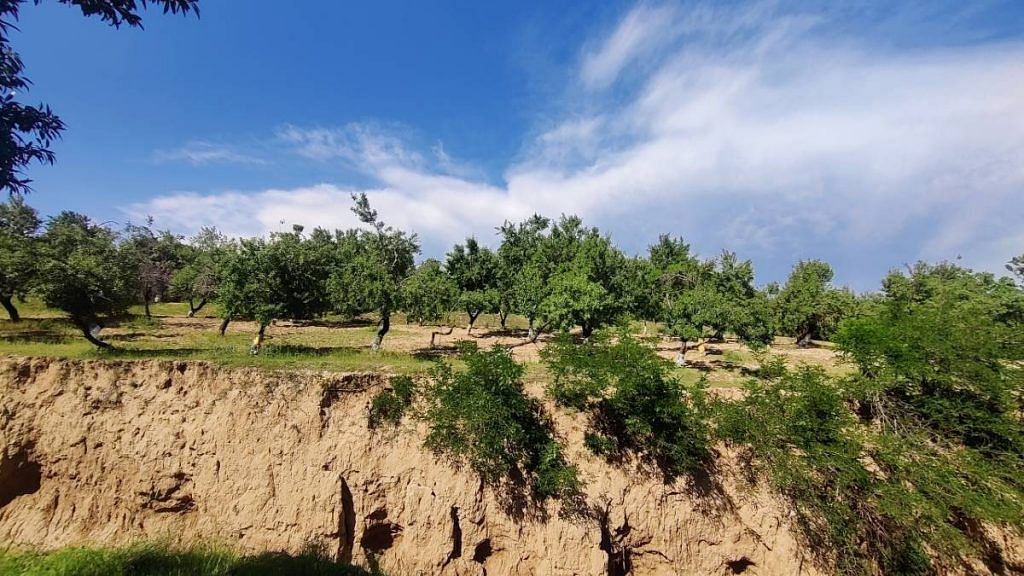Pulwama/Srinagar: Ghulam Hassan Khan had been an almond farmer all his life. He had inherited a small orchard from his father at Payar village in Jammu & Kashmir’s Pulwama.
Last year, due to stagnant prices, declining yields and skyrocketing input costs, he razed his almond farm and bought 1,000 high-density apple trees.
“Within one year, the return was two times better than almonds,” he said.
The story is similar in and around Pulwama. Traditional Kashmiri almond farmers are ditching their crop for alternatives.
On the way to Payar village, acres of almond orchards dot the road. In between are patches of apple trees, some of them high-density ones that promise better yield per tree.
Almond cultivation is less viable because of various reasons, including higher demand for imported almonds from Iran or Afghanistan, climate change, lack of irrigation and unavailability of grafting (a technique known to aid growth) in almond trees.
An official in the horticulture department of Jammu & Kashmir, speaking on the condition of anonymity, said the government has no current scheme to support almond farmers, although they’re working on one. “Almonds used to be a prime crop in the undulated hilly areas, but over the years this has declined,” he said.
The Director of Horticulture, Ajaz Bhat, didn’t respond to calls and WhatsApp messages for queries on the subject. He wasn’t at his office when ThePrint visited Monday.
Also read: Cows moo past buffaloes as India’s milk supply champions, thanks to cross-breeding
Vanishing almond farms
Data sourced by ThePrint from the Department of Horticulture, Jammu & Kashmir, shows a steady decline in the production of Kashmiri almonds.
In 1974-75 (the first year for which data is available), almonds were grown on 9,361 hectares. This peaked in 1994-95 when the crop was grown on 20,222 hectares.
This figure dropped to 7,132 hectares in 2015-16. And, in 2020-21, almonds were grown on 5,483 hectares, data sourced from the department shows.
In the meantime, India’s imports of almonds have grown by more than three times. In 2008, the imports were 34.36 metric tonnes, which rose to 115.05 metric tonnes in 2019.
The latest Foreign Agriculture Service report by the United States Department of Agriculture, which came out in 2021, noted that India’s almond imports grew by 44 per cent from 2019-20 to 2020-2021.
Why the decline?
According to farmers, the price of almonds for one mann (40 kg) has remained unchanged since 2016 at more or less Rs 6,000-Rs 6,500, while input costs have almost doubled.
They blame this on the lack of demand. “Imported variety of almonds from Afghanistan and Iran is not only cheap but they’re bigger than the Kashmiri almonds. Customers find that more attractive so they don’t buy ours,” said Khan.
He pointed out that there was a time exporters and wholesalers used to set up a temporary market every year near his town, where there was fierce competition. This ensured he got the best price for his product. “However, for the past few years, very few purchasers come to Pulwama to purchase almonds. This has reduced a farmer’s ability to demand a better price,” he added.
Government-supported high-density apples prove to be more beneficial for farmers and give returns in the first year of planting itself, so farmers choose apples over almonds.
According to the official from the horticulture department, the Kashmiri almonds got no attention while almonds from Iran or Afghanistan improved with time. “People opted for imported almonds. Over the years, returns of farmers diminished so they cut the almond trees,” he said.
The official further explained that the seedling of the almond plant doesn’t go through grafting — a horticulture technique where plants are tied together through parts like roots and branches so they aid each other’s growth and share nutrients through tissue regeneration. A vegetative propagation method, grafting can treat injured trees, help in adaptation and make trees more resistant to diseases.
The almond tree’s yield also declines quite rapidly, the official said.
The official alleged that Jammu & Kashmir failed to import planting material in abundant quantities.
Kashmiri almonds are also “early bloomers” and blossom in March-April, coinciding with the rains, which leads to loss of flower and lower quality fruit due to wind and rain. The official said that “late bloomers” are needed in the Valley so that the flower blossoms when the weather is more stable.
(Edited by Nida Fatima Siddiqui)
Also read: Delimitation shows India’s democracy continues to struggle in the face of Kashmir challenge
